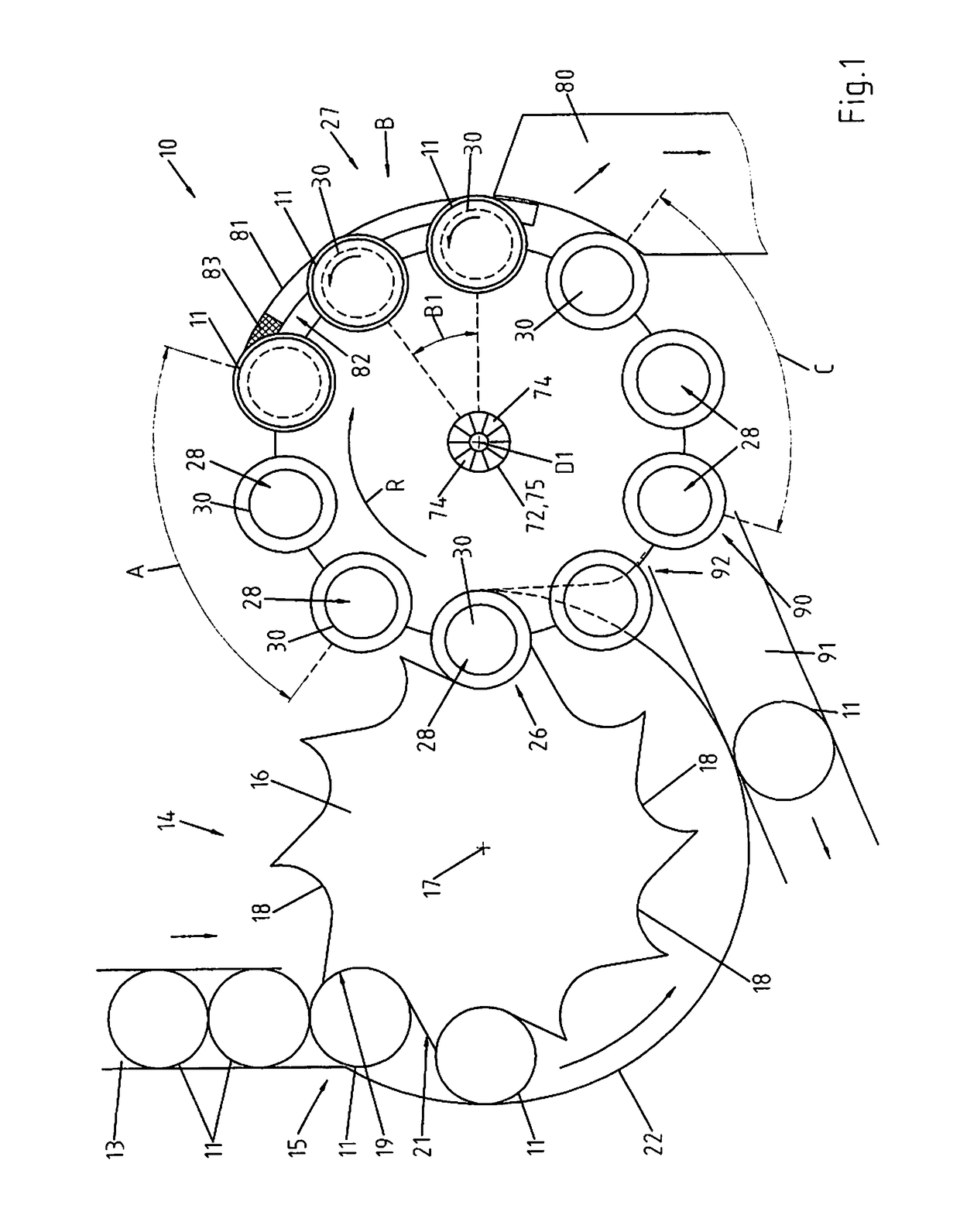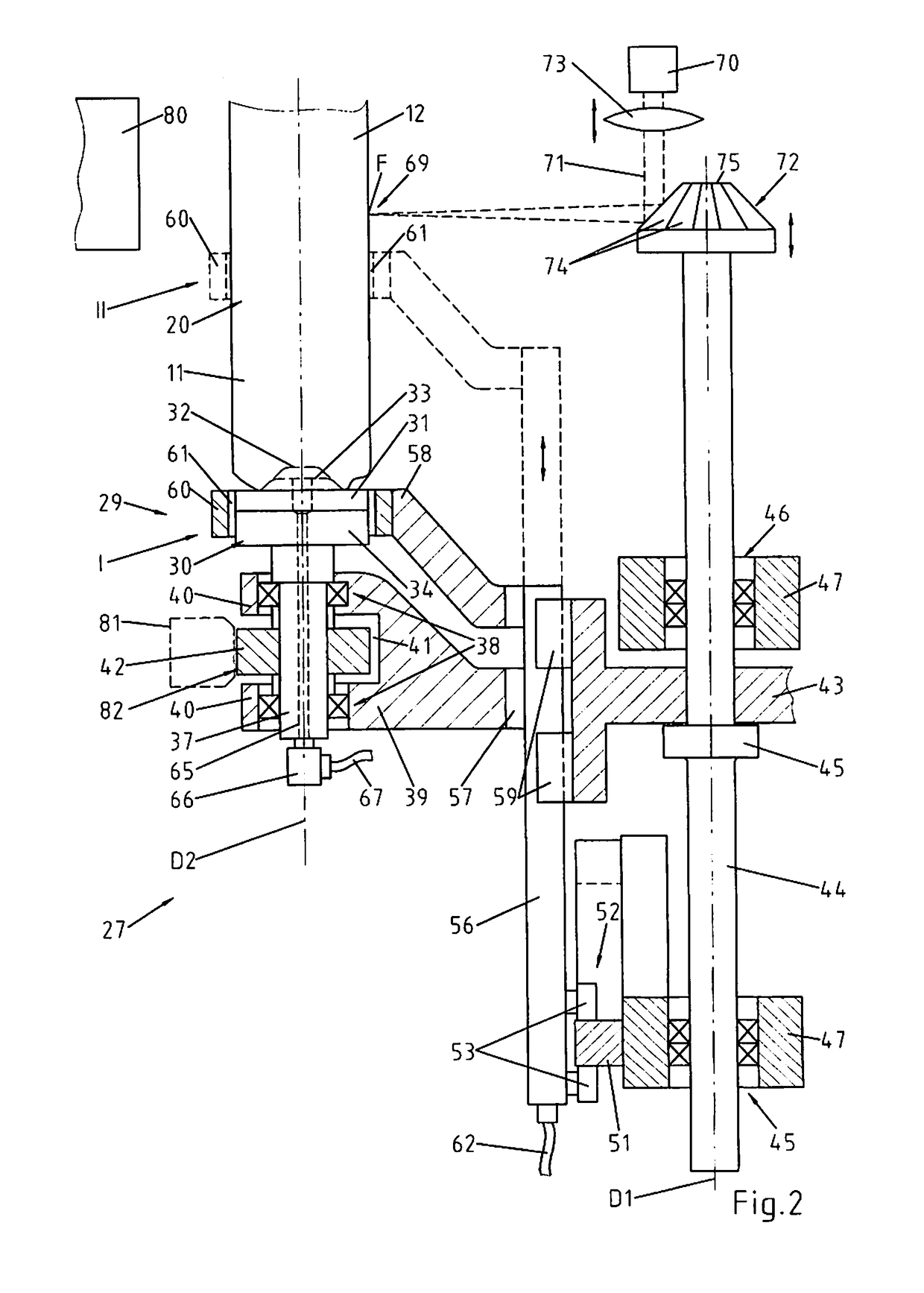[0007]In accordance with the present invention, the device for cutting a can blank comprises a first conveyor arrangement comprising several can receptacles, said conveyor arrangement rotating about a first axis of rotation. Each can receptacle is disposed to accommodate one can blank. The can blank is positioned and held in the can receptacle by means of a holding arrangement. The holding arrangement comprises a plate that can be rotated about a second axis of rotation, in which case the second axis of rotation coincides, in particular, with the longitudinal axis of the can blank. A cutting means moves so as to be adapted to the movement of the conveyor arrangement and, in particular, to the rotational speed of the can receptacle about the first axis of rotation. During the cutting operation, the affected can blank can thus be moved about the first axis of rotation, as well as about the second axis of rotation. Because any stopping or delay of the conveyor arrangement during the cutting operation is not required, machining of a large number of can blanks per unit of time is possible. In a first exemplary embodiment of the device, the conveyor arrangement rotates at 210 revolutions per minute and comprises ten can receptacles. In this manner, it is possible to process 2100 cans per minute. The duration of contact of the cutting means with the can blank is very short and preferably less than 100 milliseconds, for example 15 to 50 milliseconds.
[0009]Alternatively, it is also possible to use a laser beam as the cutting means. A laser source for generating the laser beam is stationarily mounted to a machine frame, so that the conveyor arrangement and the can blanks will move relative to the laser source. For example, a solid state laser and, preferably, a fiber laser can be used as the laser source. The laser beam may be emitted as a continuous beam during the duration of contact. The device comprises a deflecting arrangement that is arranged between the laser source and a machining region and deflects the laser beam to the can blank in the machining region. To accomplish this, for example, the deflecting arrangement may have at least one reflecting surface. In doing so, the deflection of the laser beam is adapted to the rotational movement of the conveyor arrangement or the can blank about the first axis of rotation. The location of the focus of the laser beam remains unchanged relative to the first and / or second axes of rotation while the can blank is being machined. Due to the deflection that is adapted to the movement of the can blank about the first axis of rotation and due to the rotation of the blank can about its longitudinal axis, the can blank can be machined along is entire circumference, without requiring a change of the location of the focus. At the same time, the conveyor arrangement rotates continuously about the first axis of rotation.
[0012]In a preferred embodiment, the holding arrangement comprises a holding element that can be moved between an inoperative position and a holding position. In the inoperative position, the holding element clears the can receptacle, so that a can blank can be accepted or released. In the holding position, the holding element secures and supports the can blank in the can receptacle. To accomplish this, a part of the holding element can support the can blank on its side surface, so that an exact positioning of the can blank is ensured for laser cutting.
[0013]In order to support the can blank, the holding element may comprise, for example, an arcuate or annular support element. In the holding position, this support part may partially or fully enclose the side surface of the can blank in peripheral direction. In conjunction with this, it is particularly advantageous if the support part has an air bearing on its inside. As a result of this, the can blank can be precisely positioned. In addition, damage by scratching or even deformations are prevented.
[0015]The plate may be continuously driven or, alternatively, stop, when the can blank is received into the can receptacle and / or is released from the can receptacle. When, as is the case in one embodiment, the plate is non-rotatably connected with a drive wheel, the rotation of the can blank about its longitudinal axis can be achieved very simply by rotation of the drive wheel. In order to achieve a rotation of the drive wheel, for example, an arcuate drive rail can be provided coaxially with respect to the first axis of rotation. When the drive wheel comes into contact with the inside of the arc of the drive rail, said wheel rolls off on this side and causes a rotation of the plate about the second axis of rotation. Preferably, the length of the arc-internal side of the drive rail is greater than the circumference of the drive wheel, so that the plate or the can blank performs more than one complete rotation about the second axis of rotation while the drive wheel abuts against the contact rail. This ensures that there is sufficient time available for completely cutting off an axial end section of the can blank. Furthermore, it is possible, in a simple manner, to stop the plate while it receives and / or releases a can blank.
 Login to view more
Login to view more 


